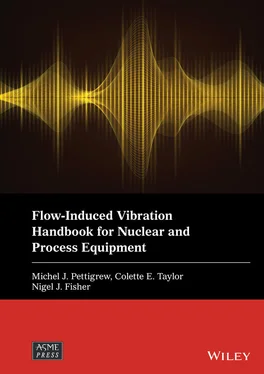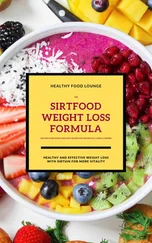For single‐phase flow f o= U p/ D and  .
.
In most cases, the random excitation forces for interior tubes are significantly lower than for upstream tubes. The vibration response of the upstream tubes will be larger. Thus, it may not be necessary to consider the vibration response of interior tubes when they are otherwise identical to the upstream tubes.
Random turbulence excitation forces can be significant in two‐phase cross flow, in particular, in the U‐bend region of steam generators. The term turbulence is used loosely in two‐phase flows. It describes the dynamics of the two‐phase mixture as it flows through a tube bundle.
For void fractions of 10% or less, two‐phase flow random forces behave like single‐phase flow forces and the single‐phase guidelines can be used. At higher void fractions, the effect of the two‐phase mixture begins to dominate the single‐phase random forces. The physics of these two‐phase forces are not well understood but recent study of the effect of void fraction and flow regime have led to reasonable collapse of two‐phase data from air‐water, Freon liquid‐vapor, Freon vapor‐water and steam‐water experiments.
Preliminary two‐phase design guidelines for random excitation of heat exchanger tubes were presented by several authors such as Taylor et al (1989), Axisa et al (1990) and Taylor et al (1996). Most of this data was obtained with air‐water mixtures, with some steam‐water data. A few years later, de Langre and Villard (1998) introduced a dimensionless scaling that simplifies that suggested by Taylor et al (1996) and more closely follows the principle used in the scaling of single‐phase random forces.
De Langre and Villard (1998) show that a two‐phase power spectral density,  , can be rendered dimensionless using Eq. (2-27)with a two‐phase pressure scaling factor, p o= ρ ℓ gD B, and a two‐phase frequency scaling factor, f o= U p/ D B. The length scale, D B, is defined as follows:
, can be rendered dimensionless using Eq. (2-27)with a two‐phase pressure scaling factor, p o= ρ ℓ gD B, and a two‐phase frequency scaling factor, f o= U p/ D B. The length scale, D B, is defined as follows:
(2‐33) 
The selection of these scaling factors is described is some detail in de Langre and Villard (1998). Many pressure scaling factors were considered, but the gravity‐based factor was the most efficient. The authors point out that gravity in the scaling factor may be related to dynamic pressure caused by the drift velocities between gas and liquid phases. More recent analysis by Taylor and Pettigrew (2019) has shown that a two‐phase pressure scaling factor of p o= ρ ℓ gD is preferred.
Using these scaling factors and the reference EPSD described above in Eq. (2-30), data from many sources were collapsed on a single plot (see Fig. 2-15). The following boundary spectra for two‐phase random forces in churn and bubbly flow were defined by Taylor and Pettigrew (2019):
(2‐34) 

Fig. 2-15 Proposed Guideline for Two‐Phase Random Excitation Forces In Churn and Bubbly Flow Regimes (Taylor and Pettigrew, 2019).
2.4.3 Periodic Wake Shedding
Periodic wake shedding, or vortex shedding, may be a problem when the shedding frequency coincides with a tube natural frequency. This coincidence may lead to resonance and large vibration amplitudes. Periodic‐wake‐shedding resonance in tube bundles subjected to liquid cross flow was observed in early research by Pettigrew and Gorman (1981).
Periodic‐wake‐shedding resonance may be of concern in liquid cross flow where the flow is relatively uniform. It is not normally a problem at the entrance region of steam generators because the flow is very non‐uniform and quite turbulent. Turbulence may inhibit periodic wake shedding in tube arrays. Periodic wake shedding is generally not a problem in two‐phase flow except at very low void fractions (i.e., ε g< 15%) (Pettigrew and Taylor, 1994). Then, the behavior is similar to liquid flow.
Periodic-wake-shedding resonance is usually not a problem in heat exchangers with shell‐side gas flow. The gas density is usually too low to cause significant periodic forces at flow velocities close to resonance. Normal flow velocities in gas heat exchangers are usually much higher than those required for resonance. However, resonance may be possible in high‐pressure components such as MSRs with higher density gas on the shell side. It could also happen for higher modes of vibration with higher frequencies corresponding to higher flow velocities. Thus, periodic‐wake‐shedding resonance cannot always be ignored in gas heat exchangers.
Generally, there is less information on the magnitude of periodic‐wake‐shedding forces in tube bundles than on the frequency of periodic wake shedding, because acoustic resonance in gas‐flow heat exchangers has proven to be a more significant problem in gas‐flow heat exchangers than tube vibration due to vortex shedding.
A recommended formulation for periodic wake shedding is given below. See Chapter 11for more detail.
Periodic wake shedding is described in terms of a Strouhal number S = f S D / U p, which formulates the wake shedding frequency, f S, and a fluctuating lift coefficient, C L, which is used to estimate the periodic forces, F L, due to wake shedding. Thus:
(2‐35) 
Periodic‐wake‐shedding Strouhal number data is summarized in Fig. 2-16where the Strouhal numbers, S t, are defined in terms of the approach velocity U ∞. Although there is a lot of scatter in the data, expressions based on Owen’s (1965) theory were proposed to formulate the average values, as shown by the curves in Fig. 2-16. These expressions can easily be transformed to yield Strouhal numbers, S , defined in terms of the pitch velocity. Thus,
(2‐36a) 
for normal‐triangular bundles,
(2‐36b) 

Fig. 2-16 Strouhal Numbers for Tube Bundles in Liquid Cross Flow: a) Normal Square, b) Rotated Square, c) Normal Triangular, and d) Rotated Triangular.
Читать дальше

 .
. , can be rendered dimensionless using Eq. (2-27)with a two‐phase pressure scaling factor, p o= ρ ℓ gD B, and a two‐phase frequency scaling factor, f o= U p/ D B. The length scale, D B, is defined as follows:
, can be rendered dimensionless using Eq. (2-27)with a two‐phase pressure scaling factor, p o= ρ ℓ gD B, and a two‐phase frequency scaling factor, f o= U p/ D B. The length scale, D B, is defined as follows:

















